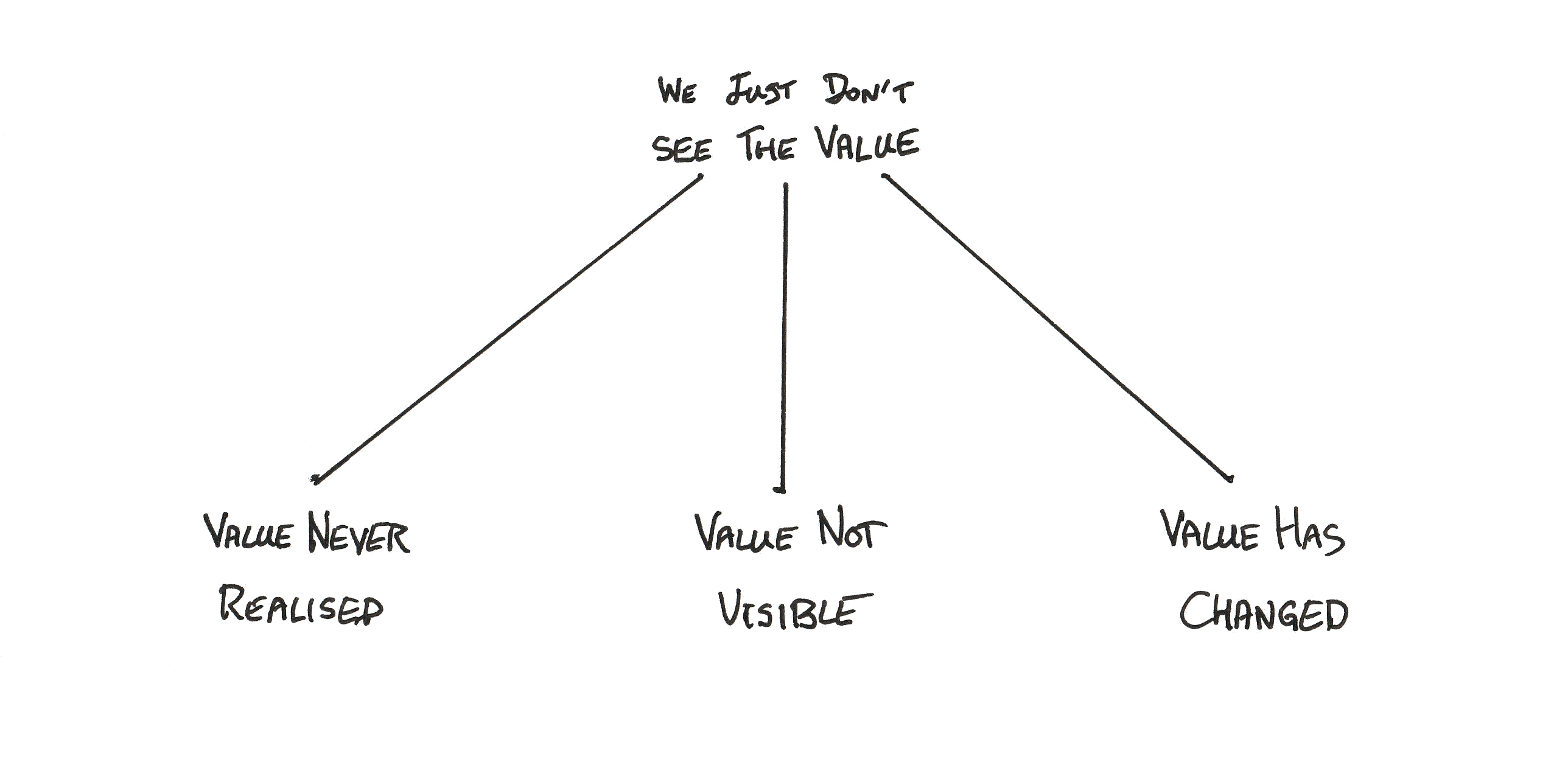
Is Agile Dead?
Towards the end of 2024, the boss sent an email to all the consultants on the team asking “Is Agile Dead?”
| Ivar |
| Team, |
|
To quote Scott Ambler: “Agile isn’t dead, but the agile gold rush is, and it isn’t coming back.” Scott’s article is well worth reading, if you haven’t already done so: https://www.linkedin.com/pulse/agile-community-shat-bed-scott-ambler-1npwc/ |
|
Another article by Jürgen Apello: “Let’s celebrate twenty-five years of Agile and ten years of “Agile Is Dead” articles. Now, I won’t be one of those heroes trying to keep the brand alive. It’s time to move on.” https://www.linkedin.com/pulse/agile-undead-synthesis-jurgen-appelo-54wne/ |
| Please, let us know your thoughts. Is it time for us to move on, and in that case, what should we do? |
“Agile is Dead” headlines are largely LinkedIn content writers seeking clickbait for their own articles, but people are after all reading them, so there is definitely disquiet with the branded one-size-fits-all promises that did not really solve the client delivery issues. There are organisations that are laying off ScrumMasters and Agile Coaches, Is Agile Dead?
Of course, Agile, or some form of it, is not really dead, it is still very widely used but the gold-rush for “paint by numbers” transformations with inexperienced staff is over. I would go further and say that customers have “soured” to single approach selling as solutions to their problems.
Rather than add more click-bait to the situation, what I felt it needed was some sensible, reasoned thinking that gets beyond the observable symptoms and starts to ask “why?”
This series of posts covers:
- What Is Agility?
- What Has Changed?
- We Just Don’t See The Value
- Won’t AI Save Us?
- What Is The Problem?
Previously we explored What Has Changed?, the nature of the industry is changing as it moves through the Technology Adoption curve. In this post we’ll explore the problems arising as the nature of the customers and their expectations change.
We Just Don’t See The Value
There are a number of instances of high-profile agile initiatives being cancelled and the associated roles being made redundant by the organisations involved. General reason cited:
| “We Just Don’t See The Value” |
The organisations were not seeing value from the agile roles, they perceived them as overhead, and they were not getting the value expected from having undergone an agile transformation.
As always, the question to ask is not what happened, but why did it happen? Now, I will fully admit to not knowing the exact details of each situation, so I am theorising somewhat. There might well be some internal politics at play in the aforementioned organisations, but those politics don’t represent the generic case1. I think that there are some fairly basic, universally applicable, reasons why the value isn’t being seen.

Figure 1: Why Do They Not See The Value?
Value was never realised
The value was never realised, the transformation did not live up to its promise. This however begs the question: Other organisations get value from Agile ways of working, so why aren’t you? What is different about you? What is different about your implementation? When you made the necessary compromises and customisations, did you make the right compromises and customisations?
The potential set of responses to the above is too large to theorise about, it would need a real context to drill down into, and whilst observing that is useful to all, the resulting advice would be specific to that context. We’ve already touched on the topic of bad instantiations of agility whilst discussing What Has Changed. There are a couple of common causes:
| Did not do enough! More than likely, just ended up with the old process divided into 2 week chunks with some agile buzzwords sprinkled over the top. Nothing really changed, therefore no improvements, no benefits. Why? Possibly the wider organisation isn’t willing to accept agility therefore it never had a chance to get a established before it was crushed by the weight of having to maintain all the old processes; easiest way to do that is just to do the old processes in 2 weeks chunks with that sprinkling of agile buzzwords to give the illusion of agility. |
|
Did too much! Focus on Agility for agilities sake rather than the real purpose of a transformation which should be around improving business results. Why? Perhaps a fixation on being agile because it’s á la mode, the thing to do, rather than using agile to realise the business needs. |
|
Duplication. Agility is instantiated alongside the old processes, without removing the old processes. Now you’re doing everything twice, twice the staff, twice the meetings, twice the reporting, twice the cost. Any rational manager2 would look at that and say “it makes no sense to do everything twice, we can get rid of something.” Which is more entrenched, the new agile ways-of-working, or the old processes? Last-in, first-out, Agility gets booted out. |
Value was not visible
Value is being realised from the Agile transformation but it is not visible because there are no metrics, or the metrics being shown are not metrics that the stakeholders are interested in.
It is very easy to fall into the trap of measuring Agility for agilities sake, instead of measuring the reasons why you wanted to adopt Agility in the first place. It’s not unreasonable for an Agile transformation to take a few years, from “Let’s do it”, to “This is how we do things around here”, even a single team takes a year for the way-of-working to become embedded to the extent where it won’t regress, massive corporations with thousands of people could take significantly longer. The average lifespan of a C-Level executive? Less than the length of the transformation! This means that at some point during the transformation there will be a change of executive, and they’re going to look at the finances and ask:
| “What have I got for all this expenditure on the Agile transformation?” |
| “Well, we’ve trained 50 ScrumMasters and Product Owners and we’ve got as many Agile Teams up and running.” |
| “and?” |
If you can’t say what you’ve actually done for the business with the Agile transformation then the likelihood is that transformation will be stopped. People trained, teams started, are Leading Indicators, useful internally to show that the transformation is making progress but not the real business metrics the business expects to see.
Whereas:
| “What have I got for all this expenditure on the Agile transformation?” |
|
“Our release cadence is now monthly, a significant improvement on the 9month cycle before the transformation and it is as fast as our customers are willing to accept at this moment in time. Significant improvements have been made to quality, no critical issues made it through to the live environments in the last release, compared that with pre-transformation levels where 25% of our effort was devoted just to incident handling of critical issues that had gone live. Employee morale, as gauged by the annual survey, is at the highest it’s been in the last ten years, and indications are that the last lingering challenges are due to the wider global economy rather than anything that the organisation is doing wrong.” |
| “Very good, I will continue to invest in these improvements.” |
Value has changed
The change to agility was enacted successfully and agility is now endemic in the organisation.
What happens to all the change agents employed to enact the change? With agility being endemic does the organisation really need an Agile Coach per team?
There will always be a need for people to facilitate the Agile processes, to hold people accountable to the principles and not let them stray too far when they have to make tactical compromises. Remember, Agility itself is a continuous journey, not a destination. Teams should always be seeking to improve, Agile Principle #12, but do those improvements need the same level of engagement, or even the same skills, as the initial adoption of Agility?
The harsh reality of change is that once the change has been made, the people enacting that change are surplus to requirement, they are no longer needed. If the change takes forever, then they are not very good change agents. The steady state of agile teams sensing and adjusting to the environment around them and continually self-improving should be handled by facilitation from within the agile teams.
Empathy For The Management
It is a common perception that the management are the enemy; they seem driven by a different set of priorities, and that’s because they are driven by a different set of priorities. Their fixation on the money is driven by the fact that they need to pay the wages at the end of the month. The money doesn’t grow on trees, it is earnt. The bigger the organisation the more detached the staff can become from the reality that it is a business and if it doesn’t make money it all stops.
If Agile Coaches could empathise with the management as much as they do the teams then perhaps we could support the management more directly.
We don’t need no stinkin’ management, we’ll self organise
Some very bright engineers at Google tried to prove that managers don’t matter. They found out that they didn’t need to be managed, the micro-management of being told what to do on a day-by-day basis, that was the bit that they, the bright engineers, could self-organise. What they still needed was someone to set the vision and direction, they needed someone to provide pastoral care, coaching, support, mentoring, advice.
They needed leadership and support; if you’re a simple agile team that would be the Product Owner and ScrumMaster respectively, or whatever your preferred brand of agility calls those roles. Scale up and you’re still going to need someone to provide the vision, and someone to coach and support.
How Do The Management Control Agility?

They can’t; that’s not how agility works!
…and that is not going to be an acceptable answer for them when they have to worry about paying everyone at the end of the month. In the absence of any sensible advice they will try to use the same old levers that they’ve always used and those historic control levers are likely to damage the agile ways-of-working rather than support them. They need to be educated about how they can influence the Agile ways-of-working.
Set the vision, help build the backlogs, close the loop by seeing the demonstrations of what has been achieved. Dependent upon organisation scale this could be happen at team, team-of-teams, or team-of-team-of-teams level. Without clarity of vision the teams won’t have any way of knowing whether their decentralised decisions are contributing to the vision. Without the accountability loop being closed by asseessing whether the work done is achieving the vision, the teams won’t know whether they’ve done the right thing. Setting the vision and closing the accountability loop around whether that vision is being achieved is the role of management and the principal level for steering the agile ways-of-working.
It will self-correct
Once the current middle managers that have always existed in an Agile environment supplant the old executive whose training hasn’t progressed beyond Taylorism and the prescriptive methods that assume everything is deterministic, then Agile and an understanding of Agile becomes endemic.
The managers that I taught and coached 10 years ago in some of the innovators and early adopters are now the CTOs and CEOs of other organisations, they know the benefits of adopting agility because they’ve seen them, and they want to replicate that in their new situation.
Caveat Emptor
Buyer beware.
Why are you doing the transformation?
Make sure that the true business reason for the transformation is clear. Make sure that it is measurable so that you can demonstrate that the transformation is doing the right thing. Make sure that these are business metrics not internal metrics about the transformation itself. Look towards the bottom line of the accountancy spreadsheet, the profit and loss line; not-for-profit, there will be measures, other than the money, to demonstrate that you are being successful.
Engaging a consultancy to help with the transformation?
Look closely at their method of operation; do they want to get the transformation done and then get out of the way? Or do they want to use the transformation as a way to embed themselves into your organisation so that they can extract money from you on a monthly basis?
Both are legitimate approaches.
There are organisations that would rather that some external experts are doing the day-to-day procedural running of their organisation allowing them to focus vision and strategy; this is why the big IT consultancies exist, to be the doing arm of an organisation that doesn’t want to be doing the doing themselves.
There are organisations that want the external experts to help upskill them as part of the transformation so that they can run their organisation themselves from that point forward.
Which are you? Make sure that that is clearly written into requests for quotations and the contracts.
Revolutions can only last so long before their result becomes the norm
Next
We Just Don’t See The Value is a symptom of a deeper underlying problem, that the instantiation of the framework has gone wrong. The next post explores the question of Won’t AI Save Us?

|
#1 It might be as simple as: Shareholders expect profit. Cutting expenses is the easiest way to profit. Those roles don’t seem to be doing much, cut them! Agility has ended up as an innocent bystander caught up the corporate shenanigans of always ensuring that the numbers go up; especially the year-on-year profits. [Return]
#” Rational managers can be quite rare; if you have one keep hold of them, lest the organisation replace them with an irrational manager! [Return]

|
Without wanting to fan the flames of more click-bait, I hope the above has provided more insight into: Is Agile Dead?

